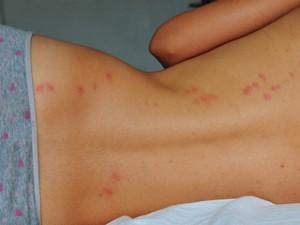
How Do I Know I’ve been Bitten?
You don’t usually feel anything when a bed bug bites. They are able to inject an anesthetic compound so sticking mouth parts into your skin is not painful. An anticoagulant prevents clots from forming so they can feed. It can take one to a few days for bite marks to appear and sometimes up to 14 days.
The area might be red or slightly swollen. Your skin might become irritated while itching may cause you to scratch and trigger more inflammation. The pattern can be random or bites may be clustered or in straight or zigzag lines. Overall, they look like the bites of many other insects, including mosquitoes.
The Symptoms Vary
People have vastly different reactions to bed bug bites. You may not have any bite marks. Others develop secondary skin problems such as infections, which may need to be treated with antibiotics or corticosteroids. Some people report anxiety and insomnia because of the discomfort and emotional turmoil bed bugs can cause.
On the extreme end of the spectrum, people can have severe allergic reactions. Bite marks can spread and form large and uncomfortable rashes, additional swelling, and hives. The site may become painful but, in rare cases, life-threatening conditions such as anaphylaxis may occur. Signs of a serious reaction include fever, difficulty breathing, feeling sick, large blisters, or irregular heartbeat.
What to Do About Bed Bug Bites
Usually nothing. Try not to scratch the area or use an anti-itch cream. Most of the time, the bite marks go away in a week or so. Infections can be prevented by washing with soap and water. If there seems to be an allergic reaction, a dermatologist can prescribe medications such as antihistamines, corticosteroids, or epinephrine. Antibiotics may be needed for more serious infections if they occur.
According to the Centers for Disease Control, bed bugs are not known to transmit any diseases among people. They are not considered a medical or public health hazard. Itching, loss of sleep, and the possibility of secondary infections are things to be alert of. These insects are otherwise unsightly and leave behind quite a mess, so are generally disliked.
How Do I know Bed Bugs Are There?
Noticing bites in the morning after you sleep is not enough to confirm a bed bug infestation. This requires seeing signs of their presence, or the bugs themselves. Rusty-looking specs of blood on mattresses, bedding, and couches are a tell-tale sign, while there may be a sweet, musty odor produced by chemicals used by bed bugs to communicate. If you smell this in your sleeping area or hotel room, this is cause for concern.
These insects also shed. If they’ve been around, you might see discarded outer shells collecting on mattresses or under couch cushions. They’re also not shy about going to the bathroom. They leave excrement wherever they go and you’ll see the tiny, black specks on surfaces where there’s an infestation. Also look for white, oval eggs in mattress seams and crevices.
An informative video and webpage are available from the American Academy of Dermatology to help you check for bed bugs.
How Did This Happen?
Bed bugs hold on tight and can get into your home after you travel. They hide easily in luggage, bags, folded clothes, and bedding. A natural ability for hiding gives these insects the ability to find places unnoticed. Even though their only nutritional source is human blood, they can go for a long time without feeding. Once they do, bed bugs can grow and multiply quickly, relying on the ability to travel and find food and even communicate using chemical signals.
Most people don’t realize bed bugs are there until an infestation has taken hold. Anyone can be a target. These insects are just that good at being stowaways.
If you really want to get rid of bed bugs today try SayByeBugs! It was developed as a safe and highly effective alternative among a sea of products that rarely deliver on their promises.